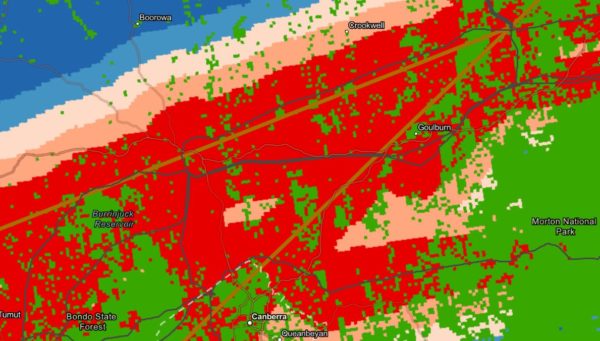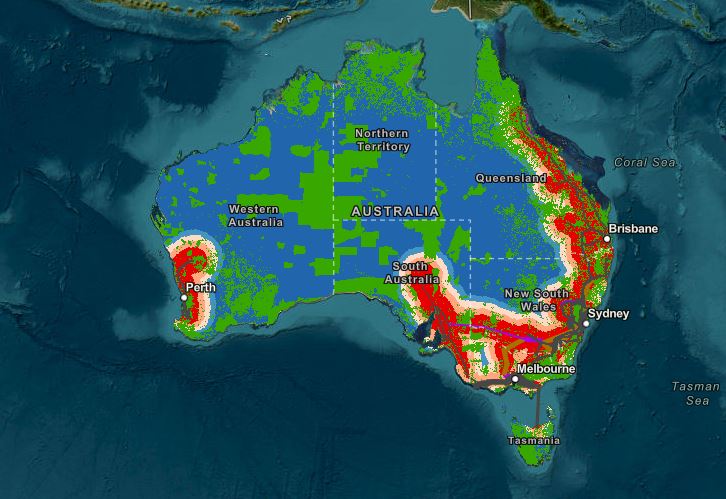With Australia’s energy system rapidly transitioning from a dependency on coal-fired power generation toward a future built on renewables, researchers from ANU in Canberra have developed a “heat map” that shows the best sites that could be used for new wind or solar farms.
The high-resolution heat maps use geographic information to identify the solar and wind potential of all prospective areas close to existing or planned high-voltage transmission lines – a consideration the researchers said is much more useful than local wind and solar data alone.
Professor Andrew Blakers, from the ANU College of Engineering, Computing and Cybernetics, said access to transmission lines is the largest constraint currently for developers of renewable energy generation projects.
“Typical power lines cross dozens to hundreds of properties and require complex negotiations with many people. In contrast, solar and wind farms generally fit on one or a few properties. That usually makes an access agreement much easier to negotiate,” he said. “All of the possible sites we’ve identified are near existing and approved high-power transmission lines.”
Each local government area in Australia has been divided into different cost categories for solar and wind generation, ranging from the strongly preferred Class A to less-preferred Class E.
Blakers said the maps show the relative cost of renewable energy on each 1,000m x 1,000m parcel of land for solar farms and 250 m x 250 m parcel for wind. The most suitable locations are highlighted in red and less preferred sites are outlined in pink or blue, while unsuitable areas, including urban areas, protected areas and native forests have been excluded from the study and are shown in green.
Popular content
Users can zoom and pan across the maps, clicking on a pixel to obtain an indicative relative cost of generating solar or wind electricity (AUD/MWh) for that location. It includes the cost of energy from a solar or wind farm plus the cost of a low-voltage powerline to the nearest existing or planned high-voltage transmission lines. The tool does not include costs for environmental and geotechnical approvals, substations, etc.
Blakers said the area between Goulburn and Lithgow in New South Wales is especially suitable for new clean energy projects because it is well serviced by transmission lines and has good wind and solar resources.
“In Victoria, the Yallourn district is attractive because of good wind potential and strong existing transmission into Melbourne, plus there’s a need to replace local coal industry jobs. There’s also extensive wind potential west of Melbourne,” he said. “South Australia has excellent wind and solar potential to the east of the St Vincent and Spencer gulfs, while Queensland’s best wind and solar sites follow the coastal transmission lines north from Brisbane in areas such as Rockhampton and Mackay. Perth, on the other hand, has an abundance of suitable solar and wind sites close to transmission lines that run from the north and the south of the city.”
Tasmania has extensive wind resources along the north coast, and on King and Flinders islands and in Bass Strait, but the researchers said their development depends on the Marinus Link being constructed across Bass Strait.
ANU PhD researcher Cheng Cheng said it is hoped the heat maps project will help accelerate the development of renewable energy projects by empowering farmers, communities and local councils when negotiating with developers.
“If landowners or local councils are able to access this sort of information and collectively approach developers themselves, it could speed up the development process,” he said. “This can also assist the solar and wind farm developers by reducing the complexity and time required to gain legal access and community acceptance.”

This content is protected by copyright and may not be reused. If you want to cooperate with us and would like to reuse some of our content, please contact: editors@pv-magazine.com.



2 comments
By submitting this form you agree to pv magazine using your data for the purposes of publishing your comment.
Your personal data will only be disclosed or otherwise transmitted to third parties for the purposes of spam filtering or if this is necessary for technical maintenance of the website. Any other transfer to third parties will not take place unless this is justified on the basis of applicable data protection regulations or if pv magazine is legally obliged to do so.
You may revoke this consent at any time with effect for the future, in which case your personal data will be deleted immediately. Otherwise, your data will be deleted if pv magazine has processed your request or the purpose of data storage is fulfilled.
Further information on data privacy can be found in our Data Protection Policy.